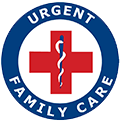A rash is a skin inflammation that changes the way the skin looks. A rash may be accompanied by itching, pain, swelling, or weeping. Try to determine the cause of a rash by checking for additional symptoms and listing recent activities. Many rashes disappear by themselves in a few days once the cause is removed, but some require medical attention. We at Urgent Family Care in Knoxville are here to help.
Common Rashes
Eczema: A red, itchy, weeping rash on tender areas of the body such as the inner elbows, back of the knees, cheeks, neck, wrists, and ankles. It has numerous possible causes, including allergies and stress. People who suffer from asthma or hay fever often have eczema.
Contact dermatitis: A rash resulting from contact with a specific chemical that directly irritates the skin, or to which a person is allergic. Examples include contact with latex gloves, costume jewelry or metal belt buckles, or clothes washed in a laundry detergent containing irritants.
Poison ivy, sumac or oak: Poison ivy rash is an allergic reaction to an oily resin (urushiol) in the leaves, stems and roots of poison ivy, poison oak and poison sumac. You might unknowingly come into contact with it on a hike, on the golf course, or in the yard. If you suspect you have come into contact with poison ivy, wash the skin immediately, preferably with dishwash soap. Wash your clothes, because the irritating oil may be on pant legs, socks, or sleeves.
Poison ivy rash develops weepy, yellow blisters. It can be very itchy and last for weeks. Mild cases can be treated with cool baths and soothing lotions. A severe or widespread rash should be seen by a doctor.
Infections: A rash caused by a fungus, bacteria, parasite, or virus that gets into the skin. Examples are athlete’s foot and impetigo. Red streaks or tender areas near the rash indicate an infection. A skin infection should be seen by a doctor.
Heat rash (miliaria): Tiny red bumps or blisters caused when the sweat glands become blocked in hot, humid weather. It usually appears on the neck and upper chest, in the groin, under the breasts, and in elbow creases. Take cool baths or showers and stay out of the heat.
Hives: Red, itchy bumps that appear quickly and last for about eight hours. They are often caused by a food allergy or a reaction to medication.
Impetigo: A bacterial infection common in children. Impetigo starts as red sores that become oozy and crusty. It often occurs when children scratch an insect bite or get dirt in a cut.
Insect bites: A rash could be a series of individual insect bites, or an allergic reaction to a single bite. Most insect bites disappear after a few days and can be treated with an itching cream. If the insect bite is accompanied by other symptoms such as nausea or difficulty breathing, see a doctor immediately.
- Bed bug bites often cause a ring of red bumps.
- A red rash on the scalp or behind the ears could be caused by lice.
- A circular rash around a tick bite could be the first sign of Lyme disease or STARI. Consult a doctor if you experience a rash around a tick bite.
- Fire ant bites develop into itching blisters. Relieve the itching with ice and itching cream. Avoid scratching or opening the blisters, which could lead to infection.
Diaper rash: Red irritation caused by exposure to urine or feces in a diaper or underwear. Keep the skin clean by washing with soap and water, and apply a protective over-the counter lotion. See a doctor if diaper rash does not clear up.
Drug reaction: Hives, redness or itching in tender areas, or a localized rash could be a reaction to a medication that you just started taking. Consult a doctor.
Ringworm: A contagious fungal infection spread by skin-to-skin contact and sharing clothes and sports equipment, such as gym equipment. It is often an angry red circle, but can be just a red patch. It can be treated with an over-the-counter cream. Follow the instructions. If the infection does not clear up in four weeks, see a doctor.
Treatment for a Rash
Rashes not caused by infections can be treated at home with over-the-counter 1% hydrocortisone cream. An oral antihistamine might help with the itching. If the rash does not clear up in a week or so, seek medical attention.
Rash Caused by an Infectious Disease
A skin rash is also a symptom of several infectious diseases, including measles, German measles, chicken pox and scarlet fever.
Seek immediate medical attention for a rash accompanied by any of the following:
- Increasing pain or discoloration
- Tightness of the throat or difficulty breathing
- Swelling of the face
- New pain or a new rash
- Fever over 100 degrees F
- Confusion or dizziness
- Severe head or neck pain
- Repeated vomiting or diarrhea
- Sore throat
Contact your health care provider if you have:
- joint pain
- a sore throat or low fever
- red streaks or tender areas near the rash (it may be infected)
- been bitten by a tick
Treatment for a rash is available at Urgent Family Care in Knoxville. Come see the doctor if a rash does not go away, is accompanied by other symptoms, or causes unpleasant discomfort.
For more information:
DISCLAIMER: The information on this page is not intended to replace the advice of a physician. It is information that is generally available. Always seek the advice of a physician or other qualified healthcare provider with any questions you may have regarding a medical condition. If you believe you are experiencing a medical emergency, call 911.
